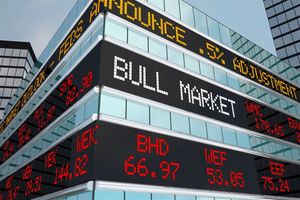
Telecommunications company Dycom (NYSE: DY) fell short of the market’s revenue expectations in Q2 CY2025, but sales rose 14.5% year on year to $1.38 billion. Next quarter’s revenue guidance of $1.41 billion underwhelmed, coming in 4.1% below analysts’ estimates. Its GAAP profit of $3.33 per share was 14% above analysts’ consensus estimates.
Is now the time to buy Dycom? Find out by accessing our full research report, it’s free.
Dycom (DY) Q2 CY2025 Highlights:
- Revenue: $1.38 billion vs analyst estimates of $1.41 billion (14.5% year-on-year growth, 2.5% miss)
- EPS (GAAP): $3.33 vs analyst estimates of $2.92 (14% beat)
- Adjusted EBITDA: $205.5 million vs analyst estimates of $191.9 million (14.9% margin, 7.1% beat)
- Revenue Guidance for Q3 CY2025 is $1.41 billion at the midpoint, below analyst estimates of $1.46 billion
- EPS (GAAP) guidance for Q3 CY2025 is $3.20 at the midpoint, beating analyst estimates by 2.9%
- EBITDA guidance for Q3 CY2025 is $205.5 million at the midpoint, above analyst estimates of $201.5 million
- Operating Margin: 14.6%, up from 8.6% in the same quarter last year
- Backlog: $8 billion at quarter end
- Market Capitalization: $7.80 billion
“Dycom’s first-half performance confirms the strength of our strategy, disciplined execution and ability to capitalize on a rapidly expanding market. This quarter, we delivered record revenue within our range of expectations and record earnings that exceeded our expectations. We meaningfully improved margins through operational efficiency and operating leverage, and strengthened our financial position through measured cash flow management,” said Dan Peyovich, Dycom’s President and Chief Executive Officer.
Company Overview
Working alongside some of the most popular mobile carriers in the world, Dycom (NYSE: DY) builds and maintains telecommunications infrastructure.
Revenue Growth
Examining a company’s long-term performance can provide clues about its quality. Any business can experience short-term success, but top-performing ones enjoy sustained growth for years. Over the last five years, Dycom grew its sales at a decent 8.9% compounded annual growth rate. Its growth was slightly above the average industrials company and shows its offerings resonate with customers.
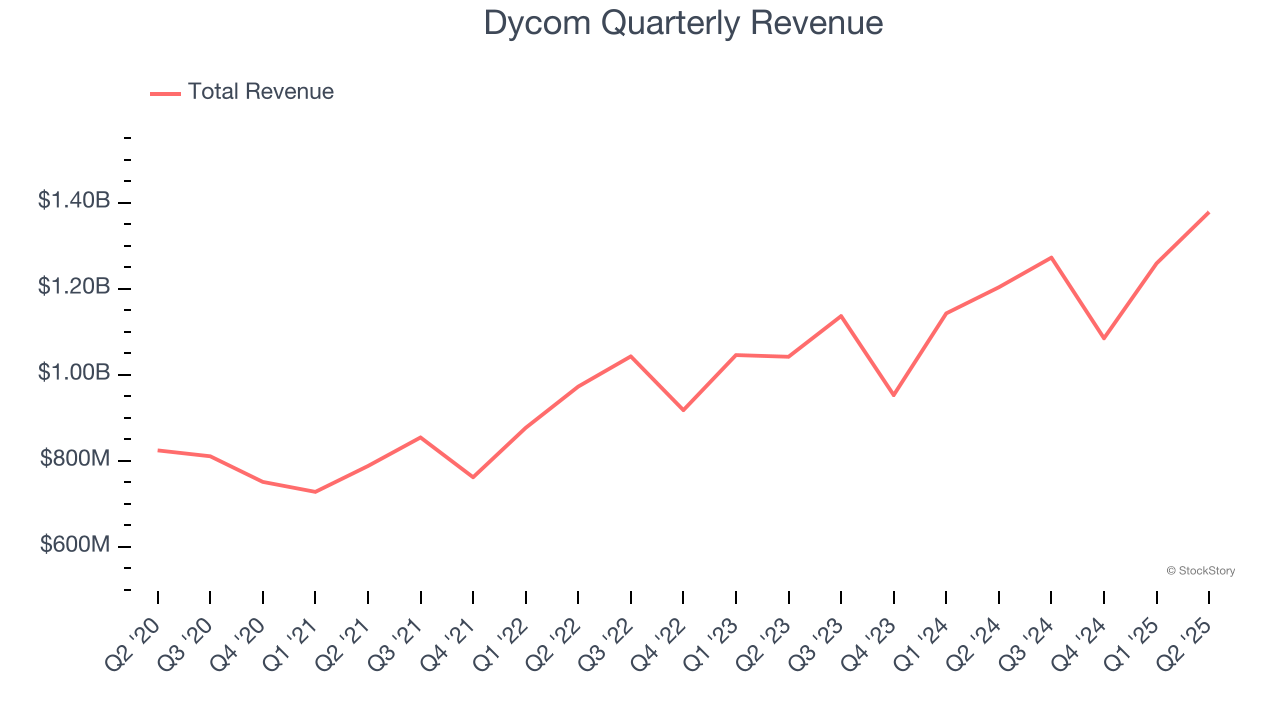
Long-term growth is the most important, but within industrials, a half-decade historical view may miss new industry trends or demand cycles. Dycom’s annualized revenue growth of 11.1% over the last two years is above its five-year trend, suggesting its demand recently accelerated. 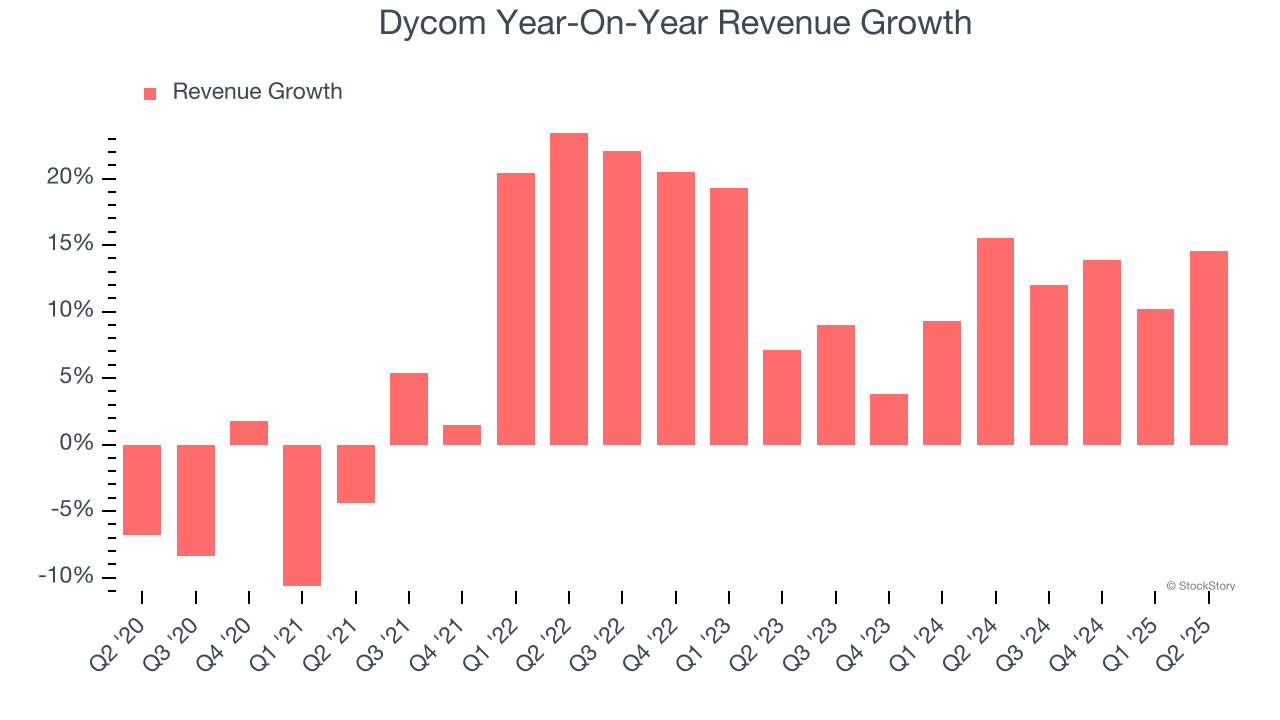
This quarter, Dycom’s revenue grew by 14.5% year on year to $1.38 billion but fell short of Wall Street’s estimates. Company management is currently guiding for a 10.5% year-on-year increase in sales next quarter.
Looking further ahead, sell-side analysts expect revenue to grow 12.7% over the next 12 months, an improvement versus the last two years. This projection is admirable and implies its newer products and services will spur better top-line performance.
Software is eating the world and there is virtually no industry left that has been untouched by it. That drives increasing demand for tools helping software developers do their jobs, whether it be monitoring critical cloud infrastructure, integrating audio and video functionality, or ensuring smooth content streaming. Click here to access a free report on our 3 favorite stocks to play this generational megatrend.
Operating Margin
Operating margin is an important measure of profitability as it shows the portion of revenue left after accounting for all core expenses – everything from the cost of goods sold to advertising and wages. It’s also useful for comparing profitability across companies with different levels of debt and tax rates because it excludes interest and taxes.
Dycom was profitable over the last five years but held back by its large cost base. Its average operating margin of 6.4% was weak for an industrials business. This result isn’t too surprising given its low gross margin as a starting point.
On the plus side, Dycom’s operating margin rose by 6.3 percentage points over the last five years, as its sales growth gave it immense operating leverage.
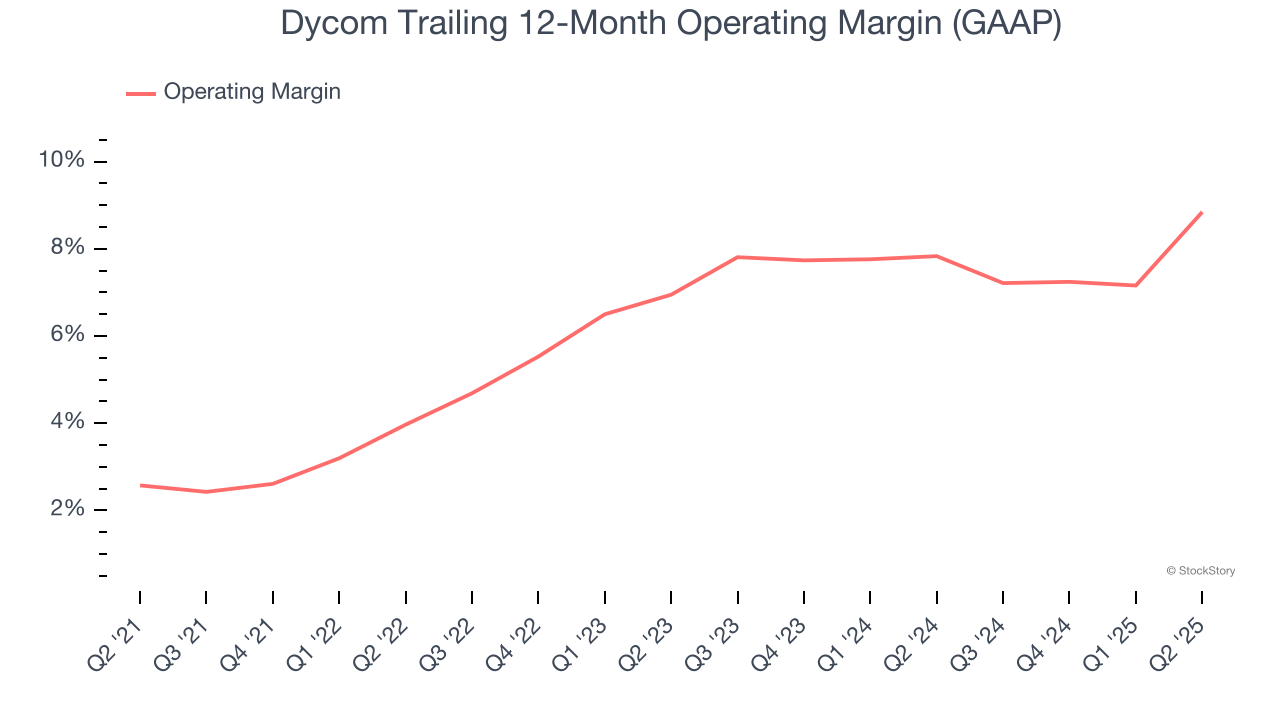
This quarter, Dycom generated an operating margin profit margin of 14.6%, up 5.9 percentage points year on year. The increase was solid, and because its operating margin rose more than its gross margin, we can infer it was more efficient with expenses such as marketing, R&D, and administrative overhead.
Earnings Per Share
We track the long-term change in earnings per share (EPS) for the same reason as long-term revenue growth. Compared to revenue, however, EPS highlights whether a company’s growth is profitable.
Dycom’s EPS grew at an astounding 28% compounded annual growth rate over the last five years, higher than its 8.9% annualized revenue growth. This tells us the company became more profitable on a per-share basis as it expanded.
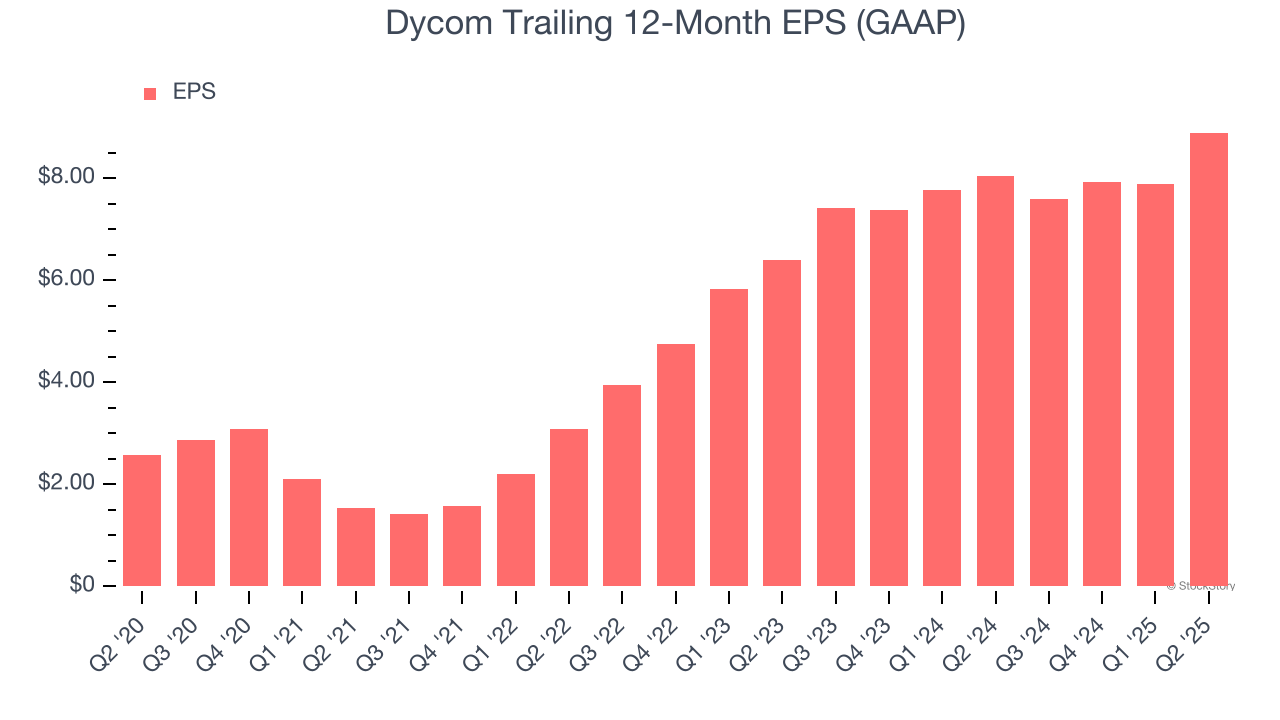
We can take a deeper look into Dycom’s earnings quality to better understand the drivers of its performance. As we mentioned earlier, Dycom’s operating margin expanded by 6.3 percentage points over the last five years. On top of that, its share count shrank by 9%. These are positive signs for shareholders because improving profitability and share buybacks turbocharge EPS growth relative to revenue growth. 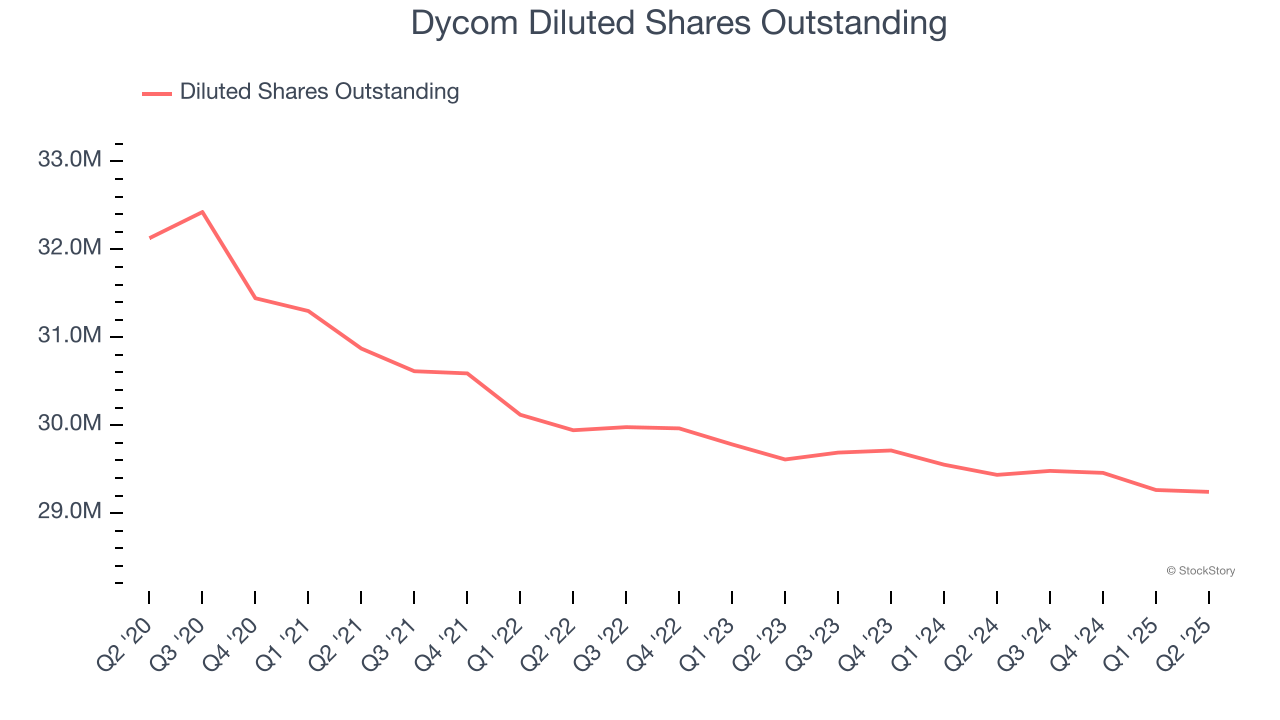
Like with revenue, we analyze EPS over a more recent period because it can provide insight into an emerging theme or development for the business.
For Dycom, its two-year annual EPS growth of 17.9% was lower than its five-year trend. We still think its growth was good and hope it can accelerate in the future.
In Q2, Dycom reported EPS of $3.33, up from $2.32 in the same quarter last year. This print easily cleared analysts’ estimates, and shareholders should be content with the results. Over the next 12 months, Wall Street expects Dycom’s full-year EPS of $8.89 to grow 14.1%.
Key Takeaways from Dycom’s Q2 Results
We enjoyed seeing Dycom beat analysts’ EBITDA expectations this quarter. We were also glad its EPS outperformed Wall Street’s estimates. On the other hand, its revenue missed and its revenue guidance for next quarter fell short of Wall Street’s estimates. Overall, this was a weaker quarter. The stock traded down 6.9% to $250.95 immediately following the results.
Is Dycom an attractive investment opportunity right now? We think that the latest quarter is only one piece of the longer-term business quality puzzle. Quality, when combined with valuation, can help determine if the stock is a buy. We cover that in our actionable full research report which you can read here, it’s free.


